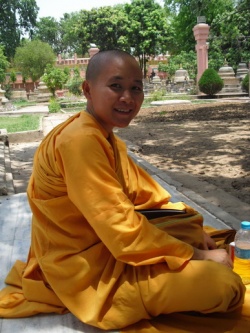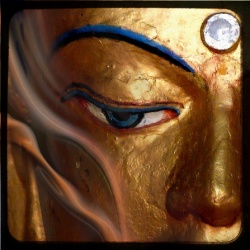The true origins of suffering or dissatisfaction of human living (Second Noble Truth), as teached by the XIV Dalai Lama
- “The Four Noble Truths are the very foundation of the Buddhist teachings, and that is why they are so important. In fact, if you don’t understand the Four Noble Truths, and if you have not experienced the truth of this teaching personally, it is impossible to practice the Buddha Dharma. Therefore I am always happy to have the opportunity to explain them”.
- ~ The XIV Dalai Lama, Tenzin Gyatso (*)
The XIV Dalai Lama, Tenzin Gyatso, have been teaching the Four Noble Truths of Buddha in several events and at least one of them is published and fully available on the Internet, the one given in October 7th, 1981, in Dharamsala (India), transcribed by the work of the Berzin Archives, which briefly explains the Second Noble Truth and the true origins of suffering, a subject that we’ve been discussing recently here. “The ultimate origin is the mind“, says the Dalai Lama. He explains how the mind “grasps” the things and disturbs reality, creating identity, ownership and suffering. He doesn’t directly mention impermanence (anicca), one of the three basic facts of existence according to the Buddhist canon (the other two being the suffering or unsatisfactoriness itself, dukkha, and the insubstantiality of the self or the no-self, anatta), but that is clearly exposed in the way the Dalai Lama describes the mind – how we take things as solid (and permanent).
Interestingly enough, the Dalai Lama also doesn’t mention the word desire, not even the word “thirst” (tanha), as it is in the speeches of Buddha in the Pali texts. Focusing on ignorance and distorted ways of the mind, the teaching that follows below is simple and enlightening, it widens the panorama of the subject and opens more doors for comprehension.
The Dalai Lama also wrote a book on the subject, the “Four Noble Truths” (1996), available at Amazon, and there are also videos in the official site where we can watch teachings given in 2009, also in Dharamsala (India), here.
The teaching follows below, as it is originally published by Alexander Berzin. To access the full Dalai Lama teachings in this subject, visit the Berzin Archives.
“True Origins (of Suffering)”
By XIV Dalai Lama (via Berzin Archives)
Because this is the case, we must now investigate the cause of suffering. Is there a cause or not? If there is, what kind of cause is it: a natural cause that cannot be eliminated or a cause that depends on its own causes and therefore can be eliminated? If it is a cause that can be eliminated, is it possible for us to rid ourselves of it? Thus, we come to the second noble truth: true origins or true causes of suffering.
Concerning this, Buddhism maintains that there is no external creator and that even though a Buddha is the highest being, even a Buddha does not have the power to create new life. [In other words, a Buddha cannot create the all-pervasively affecting suffering of the tainted aggregates of a future rebirth.] So now, what is the cause of suffering?
Generally, the ultimate origin is the mind. Specifically, the mind that is influenced by disturbing emotions such as anger, attachment, jealousy, naivety, and so forth is the main cause of rebirth and all its related problems. However, there is no possibility of ending the mind, of interrupting the mental continuum itself. Furthermore, there is nothing intrinsically wrong with the deepest, subtlest level of mind [the clear light mind] itself. [By nature, it is completely pure.] However, the deepest mind can be influenced by disturbing emotions and negative thoughts. Thus, the question is whether or not we can fight and control anger, attachment, and the other disturbing emotions. If we can eradicate them, we shall be left with a pure mind that is free forever from the causes of suffering.
This brings us to the disturbing emotions and attitudes themselves, which are types of subsidiary awareness or mental factors. There are many different ways of presenting the discussion of the mind; but, in general, [[[mind]] refers to mental activity and its] defining characteristic is “ mere clarity and awareness.” [This means the activity of simultaneously giving rise to mental appearances or mental holograms of objects and cognizing them, and nothing more]. When we speak of disturbing emotions such as anger and attachment, we have to see how they are able to affect and pollute this mental activity, the mind. What, in fact, is their nature? This, then, is main focus of the discussion of the true origins of suffering.
If we ask how attachment and anger arise, the answer is that, without a doubt, their arising is assisted by our grasping for the existence of things to be established truly and findably from their own sides: our so-called “grasping for true existence.” When, for instance, we are angry with something, we feel that the object is out there, solid, true, and unimputed, and that we ourselves are likewise something solid and findable. Before we get angry, the object appears ordinarily; but, when our minds are influenced by anger, the object looks ugly, completely repulsive, nauseating, something we want to get rid of immediately. Its existence as repulsive appears to be established from its own side, by its own self-nature. The object really seems to exist in that way: solid, independent, and very unattractive. This appearance of “truly ugly” fuels our anger. Yet, when we see the same object the next day when our anger has subsided, it seems more beautiful than it did the day before. It is the same object, but it does not seem as bad. This shows how anger and attachment are influenced by our grasping for the existence of things to be established truly and findably from their own sides.
Thus, the texts on Madhyamaka philosophy state that the root of all disturbing emotions and attachment is grasping for truly established existence, in the sense that this grasping brings about these mental disturbances and supports and sustains them. Thus, the naive unawareness that grasps for the existence of things to be truly established by their own self-natures is the basic source of all our sufferings. Based on this grasping at truly established existence, we develop all kinds of disturbing emotions and attitudes, based on which we act destructively and build up a great deal of negative karmic force.
In his Supplement to (Nagarjuna’s “Root Stanzas on) the Middle Way,” Madhyamakavatara, the great Indian pandit Chandrakirti wrote that first there is grasping for the truly established existence of the self, to “me,” and becoming attached to that “me.” This is then followed by grasping for the truly established existence of things and becoming attached to them as “mine” and to “me, as the possessor of them.”
In other words, at first there seems to be a very solid, independently existing “me” that is very big – bigger than anything else – establishing its own existence by its own power. This is the basis. From this, comes the false appearance of other objects [and persons] as if their existence as well were established from their own sides. Based on that, comes the appearance of the existence of a “me,” truly established as the possessor of them as “mine.” Then, because of our taking the side of that “me,” comes the appearance of “the other,” truly established as existing from his or her own side, for instance as “my” enemy. Toward “me,” “me, the possessor of things,” and “things as ‘mine,’” attachment arises. Toward him or her, we feel distance and anger. Then jealousy and all such competitive feelings arise. Thus, ultimately, the problem is this feeling of “me” – not the mere “me,” but the false “me” with which we become obsessed. This gives rise to thinking with anger and irritation, along with speaking harsh words, and the various physical actions based on aversion and hatred. All these destructive actions of body, speech and mind build up negative karma force.
Killing, lying, and all similar destructive actions also result from the negative motivation of disturbing emotions and attitudes. The first stage is solely mental: thinking destructive thoughts based on disturbing emotions and attitudes. In the second stage, this destructive thinking leads to destructive physical and verbal actions. Immediately, the atmosphere is disturbed. With anger, for example, the atmosphere becomes tense; people feel uneasy. If somebody gets furious, gentle people try to avoid that person. Later on, the person who became angry also feels embarrassed and ashamed for having said all sorts of absurd things, whatever came into his or her mind.
When we become angry, there is no room for logic or reason; we become literally “mad.” Later, when our minds have returned to normal, we feel ashamed. There is nothing good about anger and attachment; nothing good can result from them. They may be difficult to control, but everybody can realize that there is nothing good about them. This, then, is the second noble truth.


